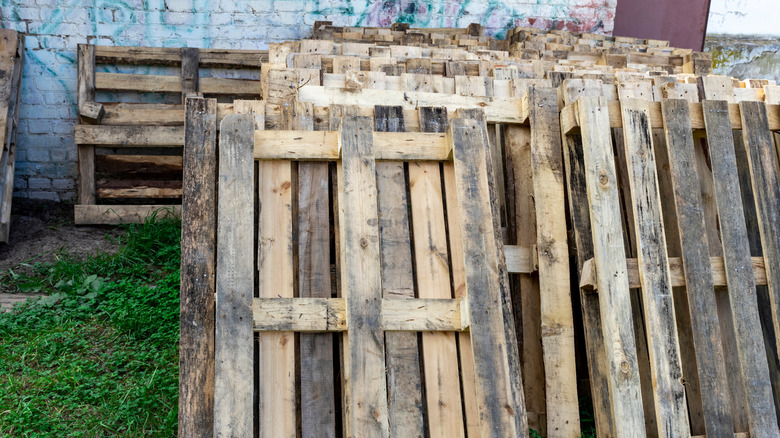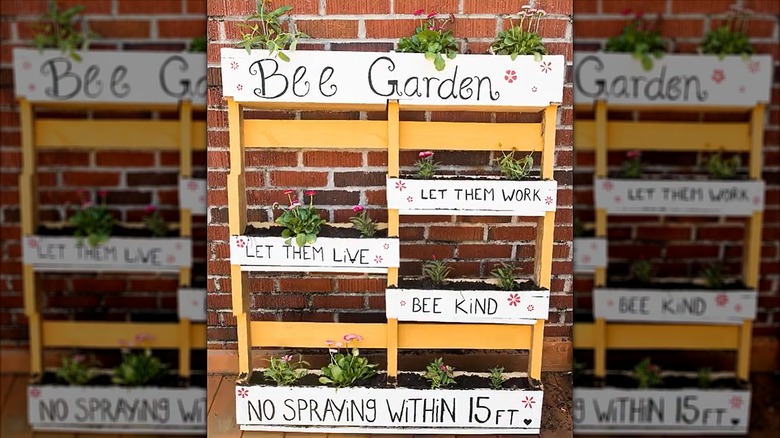Invite Natural Pollinators To Your Yard With A Wood Pallet Wildlife Mansion
Imagine a woodland home for creatures great and small, with space for birds, bees, furry friends, and flowering foliage. We don't have to grow out of Calico Critters-style fantasies in adulthood. In fact, cobbling together a dwelling for vital members of our ecosystems is a very grown-up good deed that will bring more pollinators into your yard and garden. Making it out of upcycled pallets adds adult appeal, since using these cheap or free materials won't have a negative impact on your wallet or the environment.
Stack up a few pallets layered with soil and nesting material, and tuck in nooks for nesting. Top the masterpiece with flowering plants that both you and the pollinators will love. Just be sure to call it a "wildlife mansion" to get the full thrill of this garden fixture.
Make this habitat part of your secret garden oasis with four to six pallets and a collection of natural materials like straw, grass, gravel, soil, twigs, bamboo canes, and compost. Man-made objects also have their place in this wildlife mansion. Stock up on flower seeds and a few bags of garden soil. Throw in a pile of yard waste and compost, and after a set of simple steps, your pallet palace can accommodate a menagerie.
Pull off a pallet house party
Because of their shapes, wood pallets stacked one upon another create lovely cavities that can hold growing mediums, flowering plants, and nests for all sorts of animals. Start with a layer of stones and bricks with deliberate gaps left open for animals to use as shelter. Place your first two pallets atop this foundation, and stuff the openings with straw, dried vegetation, leaves, twigs, and other yard waste.
Next come pallets three and four; these will hold more nesting materials. Along the edges, tuck in some bricks with their holes facing outwards, a DIY solitary bee house or two, and/or some pots turned on their sides and stocked with nesting material. Try to fill as many of these outer surfaces as possible with tempting nesting areas for solitary bees and other animals. Straw, sticks, and bamboo cuttings with their openings facing out are ideal. Drill a scattering of holes in the wood block sections of the pallets to house solitary bees and other insects. The best hole size for these types of bees is between ⅛ to ⅜ inches. Bricks with small holes in them and terra cotta pots filled with pinecones can be included.
Finally, layer plastic sheeting or coconut coir and sow flower seeds in soil on your uppermost pallet, or tuck in some plant starts. Water the plants and wait for your wild guests to take up residence. Alternatively, add a roof on top with tiles to keep the mansion dry.
Porch-sized pallet palace
If you have limited outdoor space, you can still get in on small-scale pollinator hospitality: One pallet will do! Use wooden pickets or scrap wood to convert the spaces between the pallet's slats into planting box shelves. Trick out as many slats as you want, but leave some where you can hang bee houses as well. Reuse old soup cans to make bee hotels. Equipped with rolls of paper, used drinking straws, or pen casings, these tunnels will appeal to solitary bees. If you choose to, now's the time to paint and decorate your pallet — casein paint is a good option.
Once dry, lean the pallet against a wall. If you don't think that will be enough support for the long term, you can use bungee cords to secure it to a fence. Outfit each planting box shelf with a lining that will hold soil while letting air and water pass through. Add soil, seeds, and/or plants from a nursery. Tack up your solitary bee houses, water the seeds and flowers, and await the pollinators' arrival.

